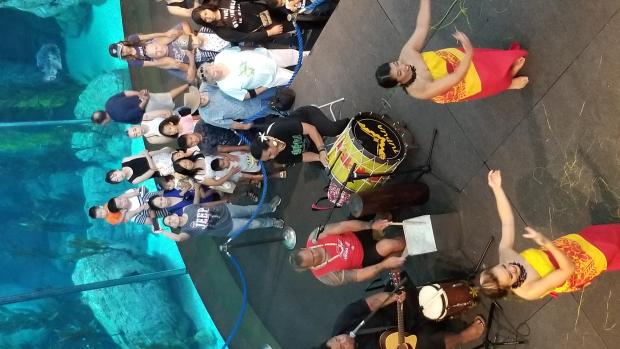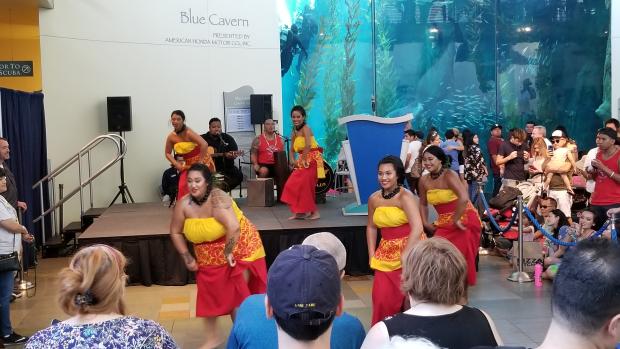Did you know that according to the 2010 Census, 1.2 million people in the U.S. are Pacific Islander heritage? With 286,145 Polynesians, Micronesians and Melanesians residing in California - which of course is located on the Pacific Coast - the Golden State is second only to the Aloha State in terms of Pacific Islander residents. As of 2010 Hawaii had 355,816 people of Pacific Island heritage, including about 200,000 Hawaiians, who are defined as individuals tracing at least part of their ancestry to the original Polynesian inhabitants of Hawaii prior to the 18th century arrival of the English explorer Captain Cook. (Simply living in Hawaii does not make one a Hawaiian the way residing in, say, New York, makes one a New Yorker.)
From June 2-3 the Pacific Islander Festival at the Aquarium of the Pacific highlighted America’s other ethnic groups. Indeed, this is the 15th annual festival putting Polynesians, Micronesians and Melanesians in the limelight, with stage performances, cultural demonstrations and more at the Long Beach-located marine life center. Marketing Events Manager Peter Martineau noted that there was a natural connection between Oceania’s indigenous Islanders and “the Aquarium of the Pacific, whose mission is taking care of the oceans for all the future generations… We accomplish that through our connection with people. Pacific Islanders obviously have taken care of the ocean. Conservation is part of their traditional culture. The ocean is their life… their songs, dances, culture revolves around the ocean.”
Barefoot Hawaiian, Tahitian, Aotearoa/New Zealand Maori, Chamorro (Natives of Guam and the Northern Marianas), Samoan and Cook Islander entertainers performed traditional dancers in flowers, sarongs and other island-wear. Some music was prerecorded, some of it played live, including by former fire knife dancer Stephan Seanoa of Tupua (see http://www.tupuaproductions.com/). The drumming on the wooden toere and other types of drums was performed live, with drumsticks pounding out throbbing beats for the “hip-notizing” hip-shaking Cook Islander and Tahitian tamure and otea executed by girls and young sarong-clad women. Bare-chested young men used their bodies as percussive instruments to beat out the Samoan slap dance. Maori females twirled and swirled poi balls attached to cords, bestowing a sort of strobe-light kind of effect.
Many of the performances took place in the Aquarium’s Honda Blue Cavern - a gigantic glass encased watery habitat full of sea life such as moray eels, leopard sharks and giant sea bass, providing a perfect backdrop for the Oceanic entertainers (who are mostly SoCal-based individuals of Pacific Islander origins). Some performances took place on the Aquarium’s outdoor grounds in the Marine Theater, where the Kiribati Dancers held forth. (Kiribati is an independent nation in Micronesia, formerly known as the Gilbert Islands.)
Cultural demonstrations and activities took place opposite the Honda Blue Cavern inside of the Aquarium’s Great Hall, where a series of booths displayed cultural artifacts and handicrafts (some for sale) of Kiribati grass skirts, Fijian cannibal forks, Marshall Island mats woven from pandanus and coconut leaves, Tongan tapa (bark beaten, treated and designed to be used as clothing or mats), Hawaiian lei making out of ti leaf, etc.
E Hula Mau, a Hawaii-oriented entity associated with the Aquarium, hosted another exhibit and is offering the Na Mamo workshops in Hawaiian language, hula, ukuele playing, etc., on June 20 and an Annual Hula & Chant Competition Labor Day (for details see: www.ehulamau.org).
Upolu, Western Samoa-born Marlena Vaifale of the Pacific Islander Health Partnership presided over a table with a kava bowl, used for making that mildly narcotic Oceanic elixir kava, popular from Samoa to Pohnpei, plus an excellent display packed with heaps of information about Fa’a Samoa - the Samoan Way. A Heritage Award accepted by a representative was bestowed upon Samoan Pastor Peniamina Sefo Taito in a presentation onstage at the Honda Blue Cavern.
As the population of Pacific Islanders continues to swell in the continental U.S., so does the demand and thirst for Oceanic entertainment and culture. In May, my daughter, the Samoan songbird Marina Davis (see: https://www.facebook.com/marina.davis.33?ref=br_rs) and the Hawaii musician Fiji packed a sold-out concert with 500 enthusiastic fans at a Las Vegas casino. The next U.S. census in 2020 will likely reveal a significant increase in the number of Polynesians, Micronesians and Melanesians whose voyages have taken them to the USA.
Upcoming Pacific Islander events in SoCal include: The Tafesilafa’i Festival July 15-19 (http://www.tafesilafai.org/) and the annual Samoan Flag Day observances. The Aquarium of the Pacific also presents other ethnic-related activities, including: Moompetam Native American Festival (Sept. 22-23) and Southeast Asia Day Oct. 13. For details see: www.aquariumofpacific.org/.
The third edition of “The Hawaii Movie and Television Book” co-authored by L.A.-based reviewer/historian Ed Rampell is now available at: https://mutualpublishing.com/product/the-hawaii-movie-and-television-book/ . Rampell lived in Oceania from 1976-1999 and often returns, including in April when he presented a Jacques Brel Film Festival aboard the cargo cruiser Aranui, which voyaged from Tahiti to the Marquesas.


